This is part of a series on the Women’s Collegiate Championships
After regaining a footing following World War II, the women’s intercollegiate golf championship started to hit its stride through the end of the 1940s. Headed by Gladys Palmer, the Tournament Committee, a branch of the Ohio State University women’s physical education department, continued to refine the processes it used to govern play. That led to an expanded and more successful event.
One constant at the tournament during this timeframe was a rather unassuming Connecticut golfer named Grace Lenczyk. Playing in her first collegiate championship in 1947 as a representative for her local Arnold College, she quickly made a name for herself by taking home medalist honors and a runner-up finish. Over the next four years, Grace enjoyed a meteoric rise in the amateur golf world that was highlighted by 4 straight collegiate individual Finals appearances, 3 (co)medalist honors, and an individual title. In-between those, she managed to collect national and international hardware, making her one of the best young golfers in the country and doing a great deal to promote the women’s collegiate game by association.
*NOTE 1: underlined text provides a link to references or sites with more information
*NOTE 2: we have done our best to cull out sources that contain problematic language or sentiments, but sometimes those things cannot be helped or are otherwise included to illustrate a point; we hope you understand this usage and recognize its educational purpose is not an endorsement
BACKGROUND
Grace Lenczyk first came to national attention in June 1946 when the Connecticut state champ eliminated legendary “Babe” Zaharias in the first ever US Women’s Open. Lenczyk would get the better of Zaharias - now the US Women’s Amateur champ - again in the Texas Women’s Open in October. This would be the last time Babe would lose for quite a while, which intrigued people even more about the young 18-year-old Connecticut girl who had managed to best the best.
Grace gave up defending her state title in the summer of 1947, choosing instead to compete in a series of national events. This proved to be an excellent move as she captured medalist honors in the Women’s Open (making it all the way to the semifinals) and won the All-American Women’s Open at Tam O’Shanter over Patty Berg. Grace Lenczyk had officially arrived and was about to take the golfing world - both amateur and collegiate - by storm.
1947 CHAMPIONSHIP
STROKE PLAY
In the Spring/Summer of 1947, Grace Lenczyk was a member of Arnold College (now University of Bridgeport) which was then a junior college in New Haven, Connecticut known as a “physical education school.” This was her (and the school’s) first appearance at the Women’s Intercollegiate Championship, but she almost missed it.
After driving all night from Chicago where she won the women’s division of the All-American tournament, Grace showed up at the famed Ohio State University Scarlet course and shot an impressive even par 78 to take medalist honors. Ohio State finally gained the 4-player team championship in their third try, beating out Michigan State and last year’s champs (minus both players) Beaver College. The two-player title went to Rollins College, however there seems to be some contention - based on the source - as to which of the two competitions was the “true” team championship.
MATCH PLAY
With a good night’s sleep, Grace was even more dangerous than before. Her first opponent was Ohio State’s Bonnie Randolph who never won a hole in her 8 & 7 loss. Her second victory came against Washington State’s Gloria Clark who fell 5 & 4. Rosann Shaffer of Rollins College kept things a little closer, but ultimately Lenczyk took the match 4&3 to earn a shot at the title.
Shirley Spork was the favorite to win the women’s intercollegiate title, even after Lenczyk triumphantly rolled into town and took medalist honors. A semifinalist last year, the Michigan State Normal (later “Eastern Michigan”) star seemed destined for a post-graduate career in golf, and would indeed find immense success at one of the 13 founders of the LPGA Tour after graduating in 1949.
The Final match was an incredible back-and-forth affair that came down to the final hole. Lenczyk, who shot a medal score of one-under par 77, had a chance to send it to extra holes but in the end came up just short on her birdie putt. Spork bettered Lenczyk by a single stroke in her 1up match play victory, earning her the individual national title.
OTHER AMATEUR SUCCESS
After the intercollegiate championship, Grace was surprised by older brothers Rudy and Dr. Ted Lenczyk with the news that they had put together enough money to fund both her college and amateur golf for the foreseeable future. She used that money to play in a series of Connecticut and national events, racking up impressive honors and even two course records (one being an incredible 4-under par 69). In September, she traveled to Toronto and capture the Canadian Women’s Amateur title, officially making her an international threat. A couple days later, Grace was competing at the US Women’s Amateur in Michigan where she ultimately fell in the Semifinals to eventual winner Louise Suggs.
1948 CHAMPIONSHIP
STROKE PLAY
Since the last women’s collegiate championship, Grace Lenczyk had transferred to John B Stetson University in DeLand, Florida to join her brother, Rudy.
For the second time, Grace skidded into town just in time to play, and for the second straight year came away with medalist honors. This year not only did she break par, she also broke the tournament and course record with her 38-34=72 (-6)1 performance. The previous record of 73 was equaled by defending champ Shirley Spork [Michigan State Normal] and the previous medal qualifying record of 74 was equaled by Marilynn Smith [Kansas], but neither was good enough to earn any hardware.
This year Rollins College brought four players - Rosann Shaffer, Clara Jane Mosack, Alice O’Neal (who married Pete Dye later that year), and Judy Baker - and returned home with their first team title since 1941. Their 18 hole score of 346 was good enough for a 21 stroke victory over the reigning champs at their home course.
MATCH PLAY
Lenczyk’s first round 6&5 victory came as no surprise, however Shirley Spork’s 3&2 loss to Alice O’Neal [Rollins] was. That left Grace the runaway favorite, which she happily lived up to with two more 6&5 wins to reach the finals. Including her 6-under par performance in stroke play, Lenczyk was 19-under par in the mere 57 holes she had played. Meanwhile, the other side of the bracket was dominated by Marilynn Smith who herself racked up impressive 6&4, 4&3, and 6&5 victories.
Smith and Lenczyk were familiar foes. In August the previous year Marilynn - then a high school student in Wichita, Kansas and two-time state champ - had shocked Grace with a surprise defeat in the early rounds of the Women’s Western Amateur. Lenczyk had played a great deal of high-level competitive amateur golf since then, and her experience showed. Grace continued to blister the course, shooting an unofficial 70 (!!!) which put her at 27-under par for the 75 holes she played in the tournament. Despite the gaudy scoring, Smith managed to hang in the match and actually took it to the 18th hole before conceding (hence the “unofficial” score) while laying 4 in a fairway bunker, giving Lenczyk the 2up victory and the well-earned title of collegiate champ.
OTHER AMATEUR SUCCESS
Lenczyk had an incredibly busy year in amateur golf, almost all of it on the national stage. In April she made it to the Finals of the North & South Amateur, coming up short (again) to Louise Suggs. The next month, the pair found themselves on the same side as members of the victorious American Curtis Cup team. It was the first playing of the competition since 1938. Almost all of the American Curtis Cup teammates stayed to compete in the Women’s British Amateur; Lenczyk fell just short of the quarterfinals but Suggs prevailed to become just the second American to bring the trophy back to the United States. Grace arrived back in the States and spent a whole half hour at home before heading straight for Ohio State.
After the collegiate championship, Lenczyk made a quarterfinals appearance in the Women’s Western Open. Although she finished 5th in her attempt at recapturing the All-American title, she was the low amateur (T4) in the US Women’s Open and successfully defended her Canadian Women’s Am championship. Her continued success made her one of the top favorites to win the US Women’s Amateur held at Pebble Beach. Not only did she succeed, she managed to cut through an impressive array of future US champions and Hall of Famers including Mary Agnes Wall, Polly Riley, and Helen Sigel in the Finals. Just a week after celebrating her 21st birthday, Grace Lenczyk was officially a national, international, and intercollegiate champion.
1949 CHAMPIONSHIP
STROKE PLAY
Things had changed tremendously for Grace Lenczyk since winning the US Women’s Amateur title. Her schedule was much lighter on play and heavier with travel through multiple states and countries. In order to maximize her play, she decided to take the Spring semester off from Stetson. This decision would have interesting consequences: despite her being away from school, she was still deemed eligible (“in good standing” with her school) to defend her intercollegiate title, and this allowed her more time at school which gave her eligibility for 1950 if she stayed that long.
Lenczyk, the reigning champ and two-time defending medalist, decided to give up her shot at a third straight run at the latter honor by exercising a privilege awarded to the former. In those days, the defending champ was awarded a spot in the match play bracket and therefore did not have to qualify. With Lenczyk electing to spend her time practicing, the honor instead went to Western Michigan’s Barbara Canine who shot a par 78.
Only two teams - Rollins and Ohio State - brought 4 players so the team title was decided again by two-player teams (“doubles”). Although Rollins had the better 4-player team score, Ohio State won back the team title with a record low two-player total of 161. One interesting point is that the doubles teams were pre-determined, not simply the two lowest scoring players from a given team; if the latter had been the case, Rollins would have tied with their own 161.
MATCH PLAY
Grace’s title defense started with a 6&5 throttling in the first round, followed by a 5&4 thumping in the second. While Shirley Spork, Lenczyk’s foe from 1947, fell in that second round, last year’s runner-up Marilynn Smith thrived. Both Lenczyk and Smith breezed back into the Finals with both Semifinals matches ending before they reached the 16th hole.
Armed with a rabbit’s foot, her lucky red skirt, and two hats, Kansas’s Marilynn Smith conjured all of the luck she could to not repeat last year’s final. Apparently it worked. While practically all of Smith’s putts found the cup, Lenczyk couldn’t buy a putt outside of two feet. Her cold putter proved her undoing as a 9 foot birdie putt on the 16th hole stopped just on the lip and ended her title defense. With a two foot tap in, Marylinn Smith, Kansas freshman, was the new collegiate champ.
A few days after the championship, Smith announced she was signing a contract with Spalding and turning pro. Her entry into the Western Open at the age of 20 made her the youngest pro in women’s golf. The next year, Marilynn Smith would join Shirley Spork and a number of other recent (and current) collegiate players as one of the 13 recognized founders of the LPGA Tour.
OTHER AMATEUR SUCCESS
This year’s amateur schedule was a little different for Lenczyk. As the reigning US Am champ - not to mention her Canadian and Intercollegiate titles - she now could basically compete in anything she wanted. So what do you do when you already have two (inter)national titles? Go for a third of course. Grace announced in early February she would play a lighter schedule and prepare for another go at the British Women’s Am, which would give her what was dubbed the “International Grand Slam”.
Things got off to a great start with medalist honors and a runner-up finish to Peggy Kirk [Rollins College] in the North & South Amateur in April. A month later, the pair traveled together to North Wales for the Women’s British Am. Unfortunately they also returned home early together after both being upset in the third round of match play.
The week after losing the intercollegiate championship to Marilynn Smith, Lenczyk set multiple records with her 66 to take medalist honors at the Women’s Western Am. She eventually lost to Babe Zaharias in the 2nd round while Smith was put out by two-time reigning champ Louise Suggs in the 1st round.
In August, Grace finished second among the amateurs at the All-American a week before winning the “World” Amateur held at the same Tam O’Shanter course. At the end of the month, she travelled to Vancouver for the Canadian Women’s Amateur, but unfortunately her title defense ended with a semifinals loss to Oregon sports Hall of Famer Marion Herron.
The final letdown came with Lenczyk’s attempted title defense at the US Women’s Am. She played what was described in the Hartford Courant (Sep 12) as “one of the worst rounds of her entire career” against Joanne Barr Tracy from Texas in the first round. Even with the terrible play, Grace had a chance to send the match to extra holes but her putt came a foot short. A fitting end to a relatively disappointing year.
1950 CHAMPIONSHIP
STROKE PLAY
An unexpected benefit of Grace Lenczyk missing so much school time for international golf was that she added more eligibility time to play for Stetson. When she did have time for collegiate golf, she managed to do some pretty incredible things such as becoming the first (only?) woman to qualify for match play in the Florida Intercollegiate held in March. Although she would get to play for the Stetson team the following Spring, this would be her last Collegiate Championship since the rule was that a player could only make four appearances.
Forced to go through qualifying again at the collegiate championship, Lenczyk made it 3-for-3 in winning medalist honors. This time, however, she had company as Betty Kerby [Berry College] matched Grace at 1-under par 77. Stetson’s other competitor, Marjorie McNeely, shot an 85 to also qualify for match play and give the university a runner-up finish (by 1 stroke!) behind Ohio State’s Pauline Frey (79) and Polly Martin (82).
MATCH PLAY
Lenczyk’s quest for a fourth straight Finals appearance started with a rematch of last year’s semifinals match against Ohio State’s Judy Baker; the winner was the same but the result was a much closer 2&1. The second round was another close match in a 1up victory over Nancy Slaw [Centenary Junior College]. Illinois’s Tommie Riley was the last hurdle which Grace cleared 3&2 after a hard-fought battle.
Betty Rowland of Rollins College was not a shoe-in for the Finals. Her first round victory (5&4) was the opposite of her second round struggle against co-medalist Betty Kerby, which was decided on the 20th hole. It was almost an all-Stetson Final, but Betty dispatched Marjorie McNeely 6&4.
Ominous skies and a strong wind greeted the pair for their Finals match. The potential weather didn’t deter the large crowd nor did it apparently affect Rowland’s shot-making skills which were on full display starting with a 60 yard hole-out on the first hole. She followed that up with another birdie on the 2nd hole and another hole-out on the 8th. Lenczyk leveraged her vast experience to hang in the match, but ultimately she ran out of holes (and hole-outs), losing 4&3.
OTHER AMATEUR SUCCESS
The word of the year for Lenczyk was “comeback” and she started what she hoped to be her year-long tour at the Women’s North & South where she won medalist honors. Despite her second round loss, there was optimism.
That optimism traveled with Grace in May to Ireland for the British Women’s Am. It carried her through two big match victories. Unfortunately, it wasn’t strong enough to carry her through a rather difficult third round match. When she returned to the United States, optimism came in the form of a pep talk from none other than Babe Zaharias looking to help Grace find herself again.
A month after the collegiate championship, Lenczyk was again selected to represent the United States in the Curtis Cup in September. Before then, she qualified for match play in both the Women’s Western Am and Canadian Am, but suffered unexpected losses in the opening rounds. By the time the Curtis Cup matches actually began, Grace’s confidence was probably reaching a low point. However, the year did end on a high note. Not only did her and her US teammates leave the Country Club of Buffalo with the Curtis Cup (again), Lenczyk got a bit of revenge with a 6&5 win over Elizabeth Price who had put her out of the British Am earlier in the year. With her withdrawal from the US Women’s Am a few weeks later, Grace’s competitive year was complete.
AFTERWARDS
After her incredible accomplishments in both college and amateur golf, Grace Lenczyk was inducted in the Stetson University sports Hall of Fame. She was also inducted into the Connecticut Golf Hall of Fame in 1969 alongside her brother, Dr. Ted Lenczyk, who was inducted the year before. She married Robert Cronin in 1958, had children, and went on to have a rich full life outside of competitive golf.
Grace (Lenczyk) Cronin passed away in 2013, leaving behind an enviable legacy which, among so many other things, included a four year stretch that made her one of the most impactful players in the early history of women’s intercollegiate golf.
Thanks for reading!
Up Next: Championship Adrift (1953-55)
In the next post for this series, we will cover the women’s collegiate championship leaving the confines of the Ohio State and becoming adrift, on the verge of cancellation.
Women’s par for the Ohio State Scarlet Course was 78 at that time, and the women’s competitive course record was 73, set by “Babe” Freese during last year’s tournament during match play.




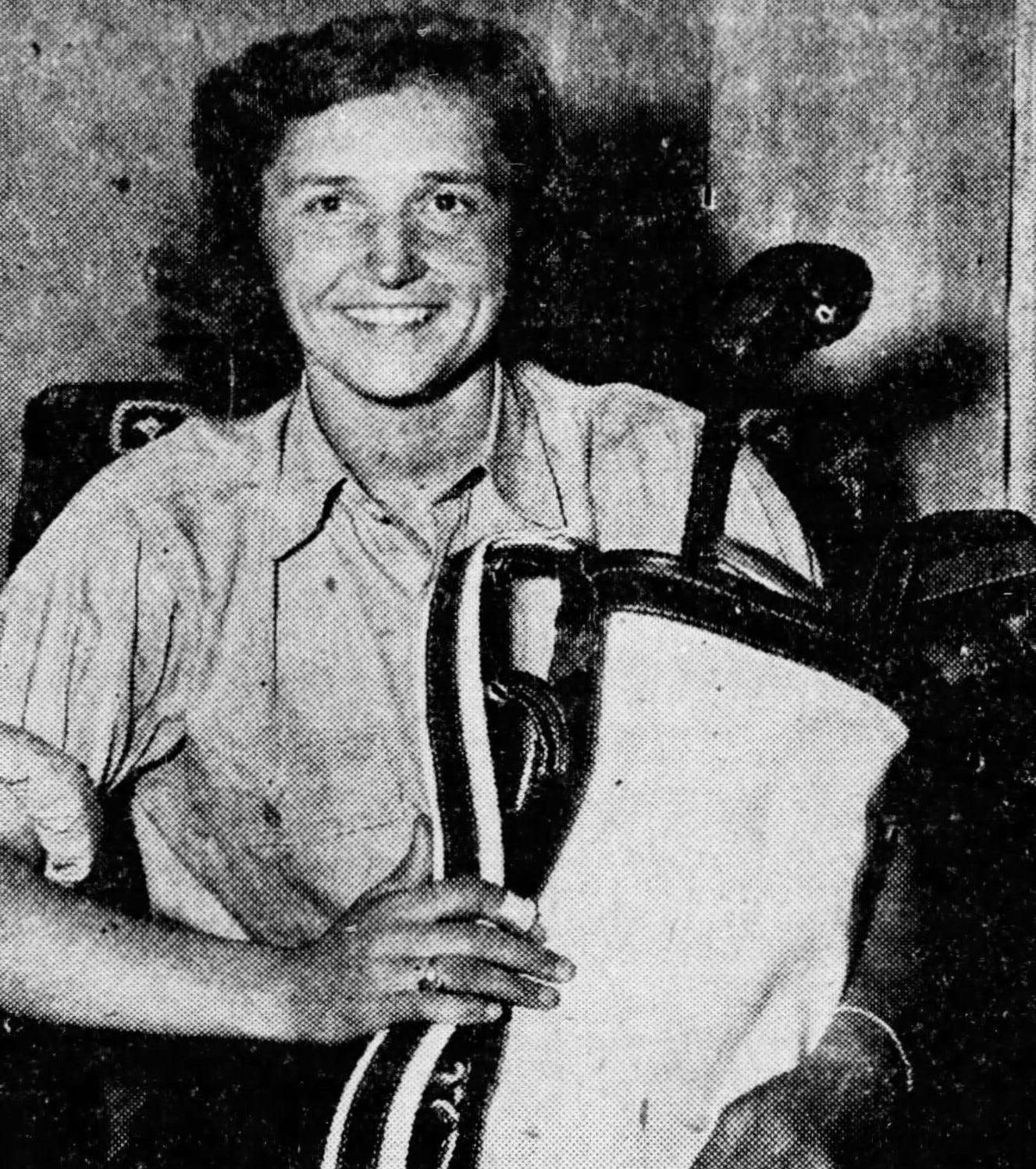
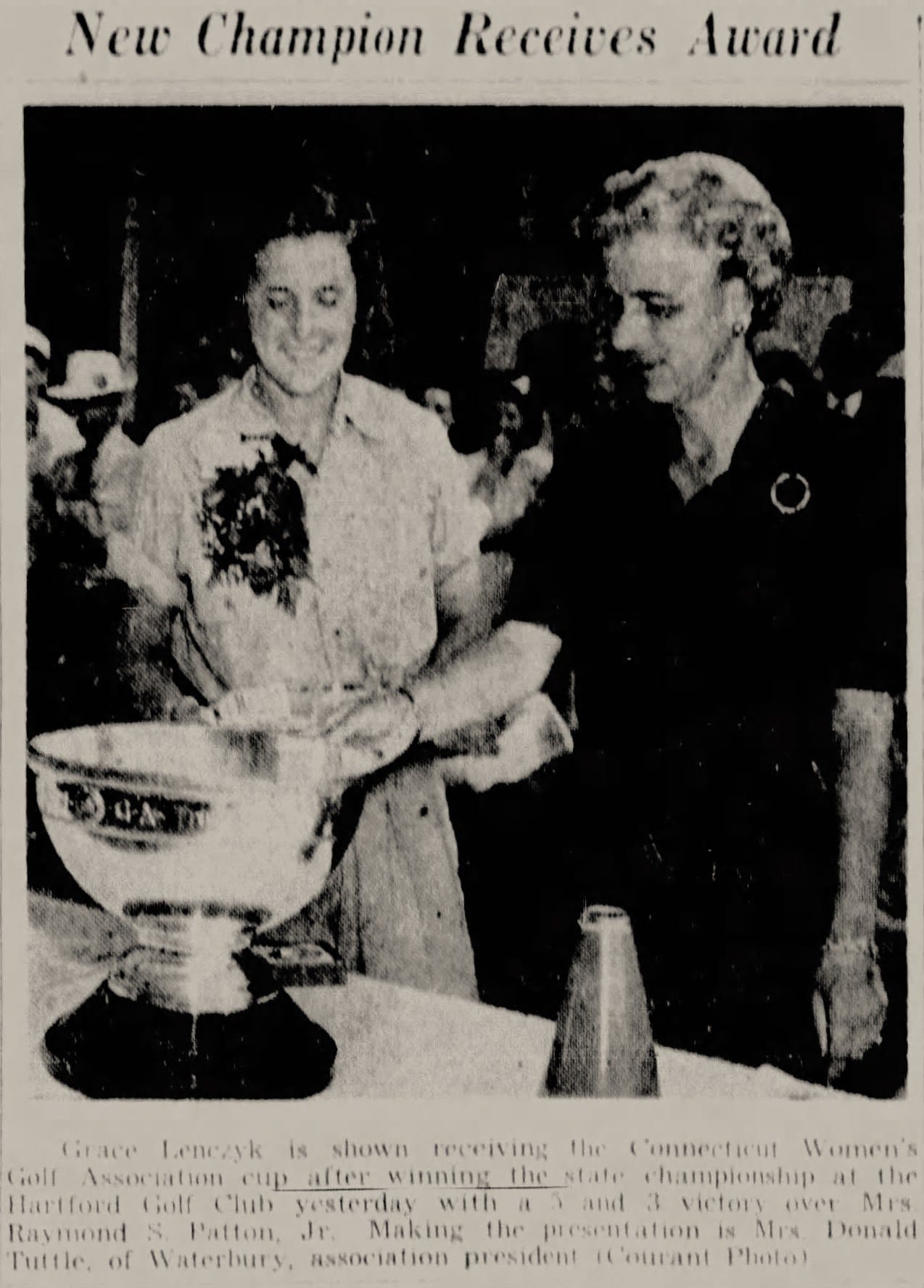

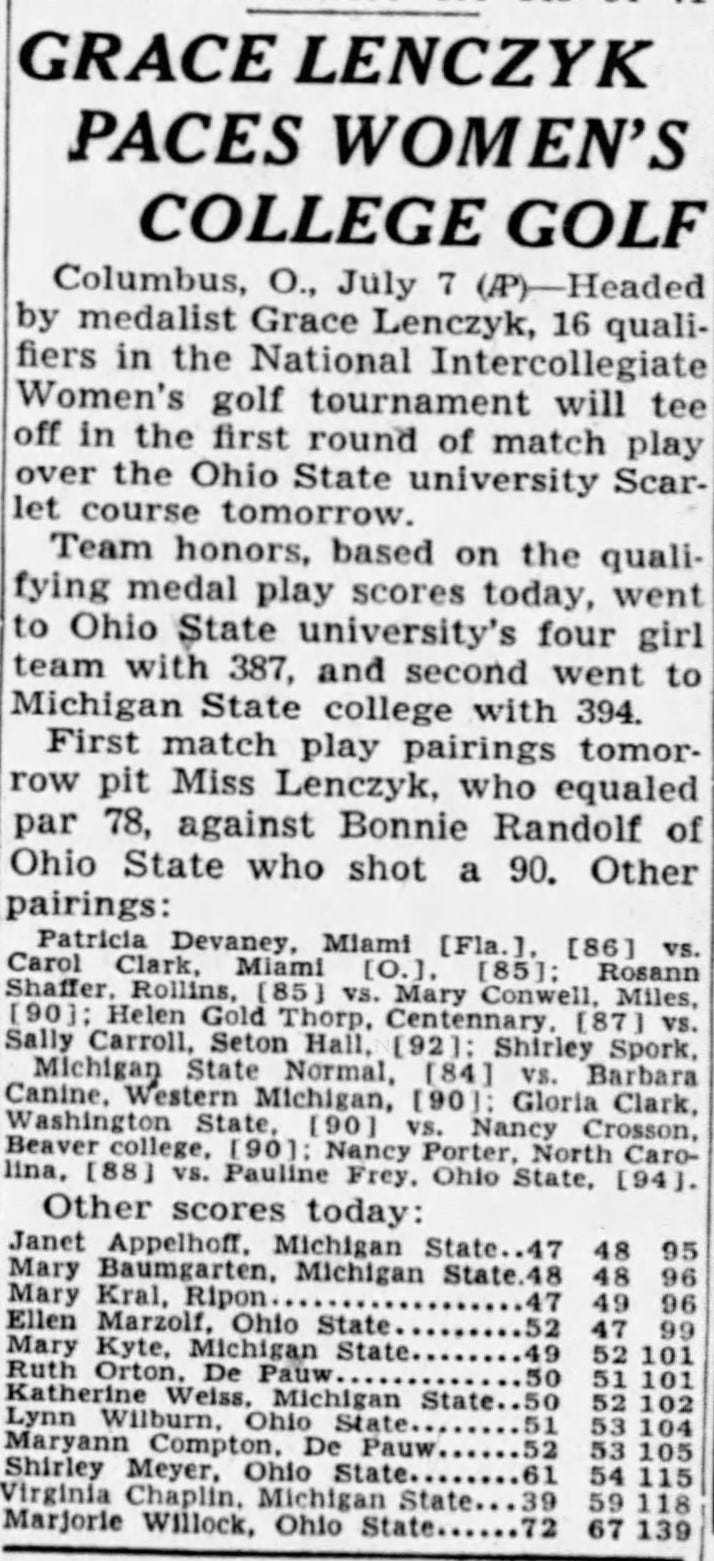
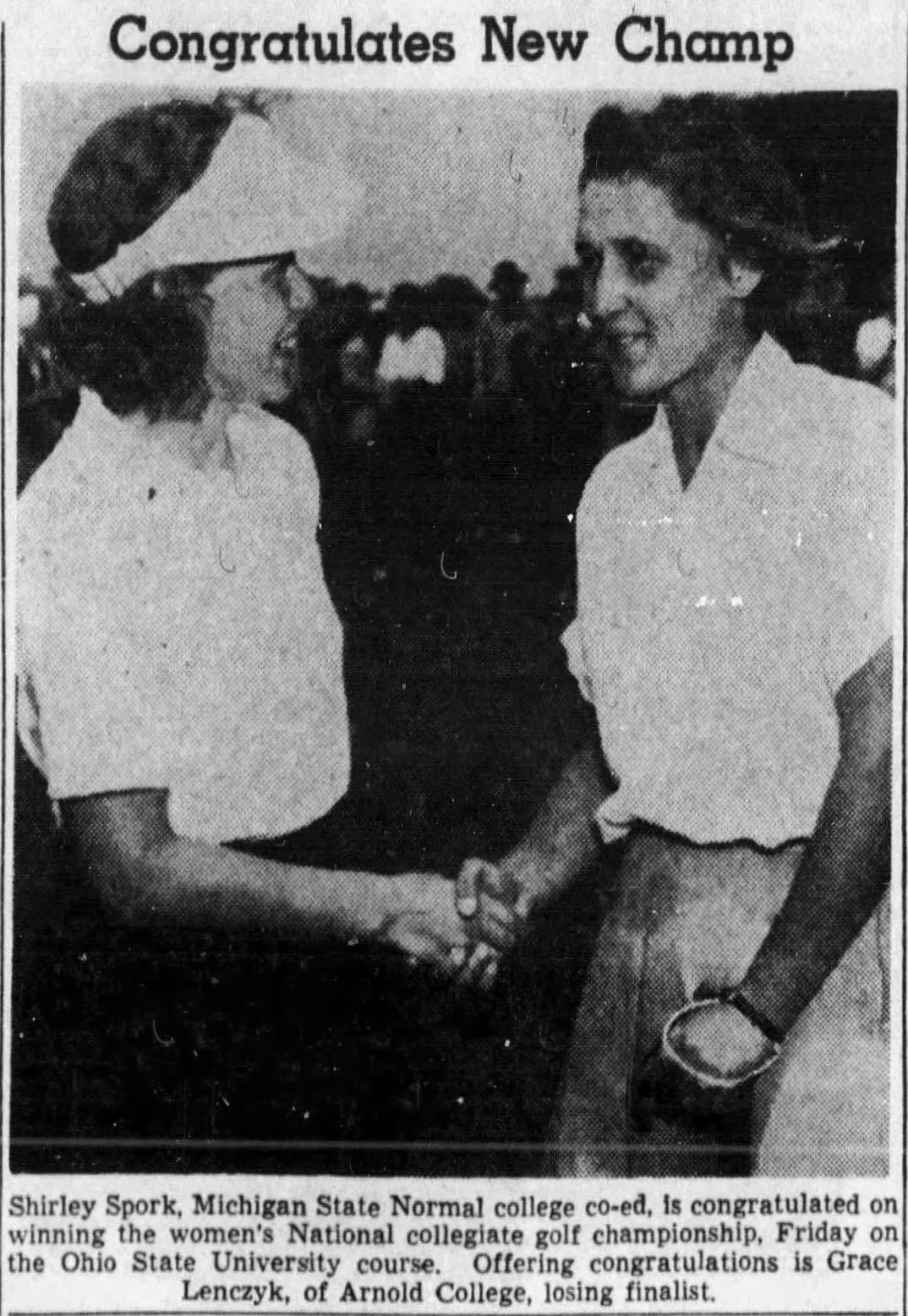
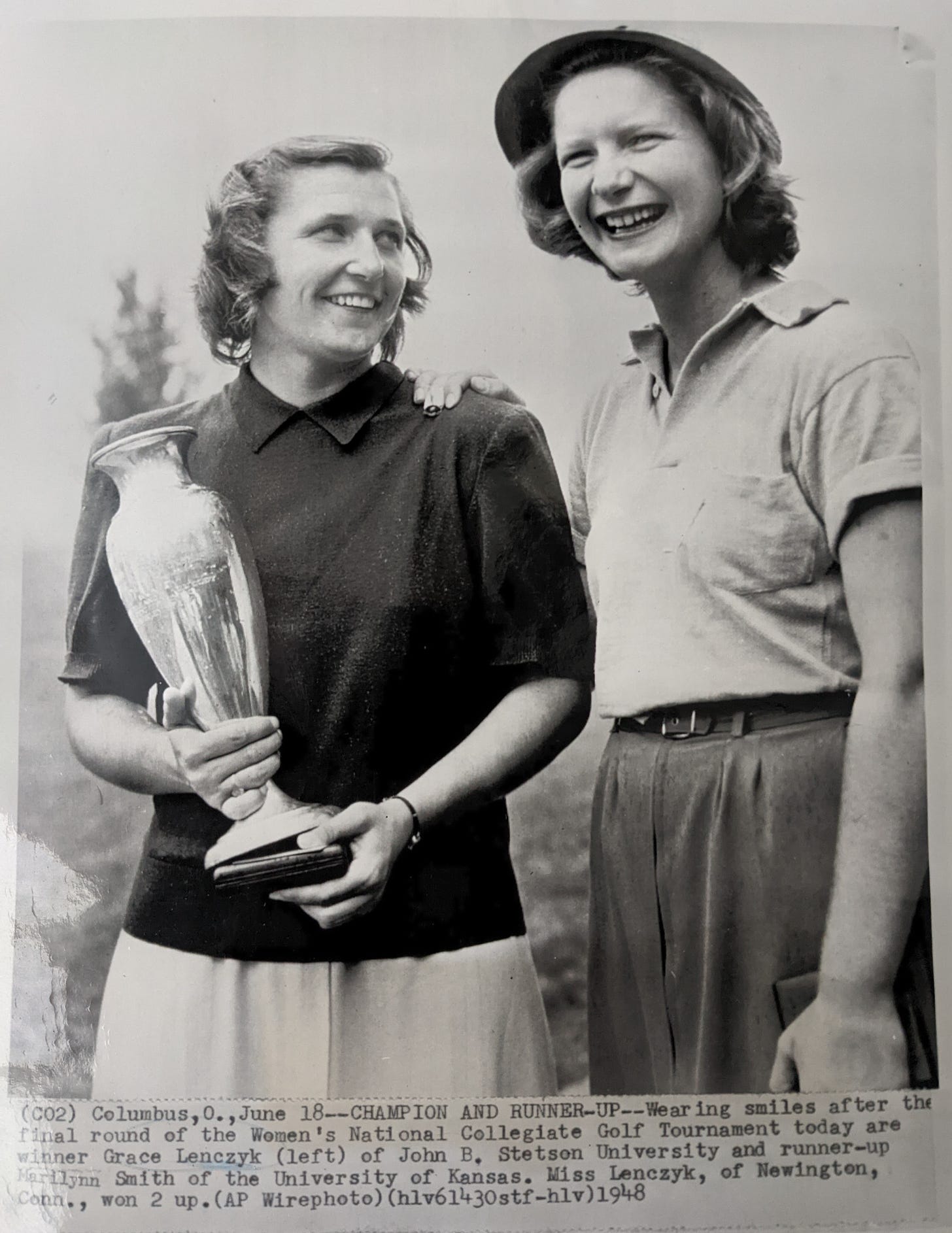
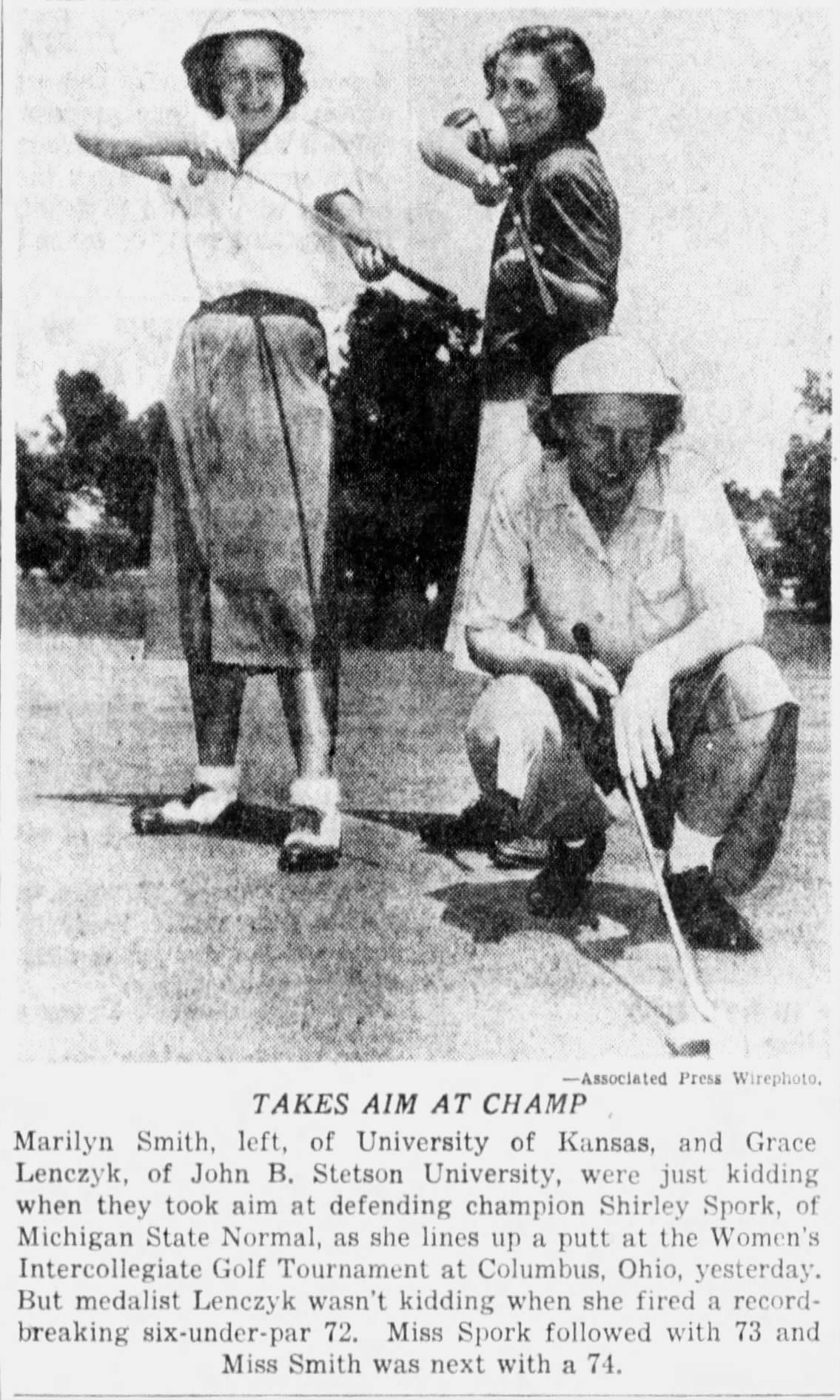
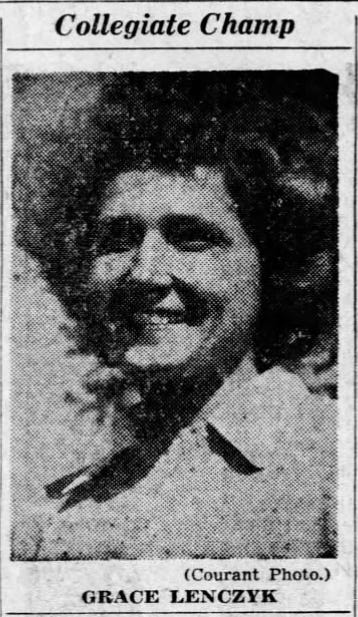
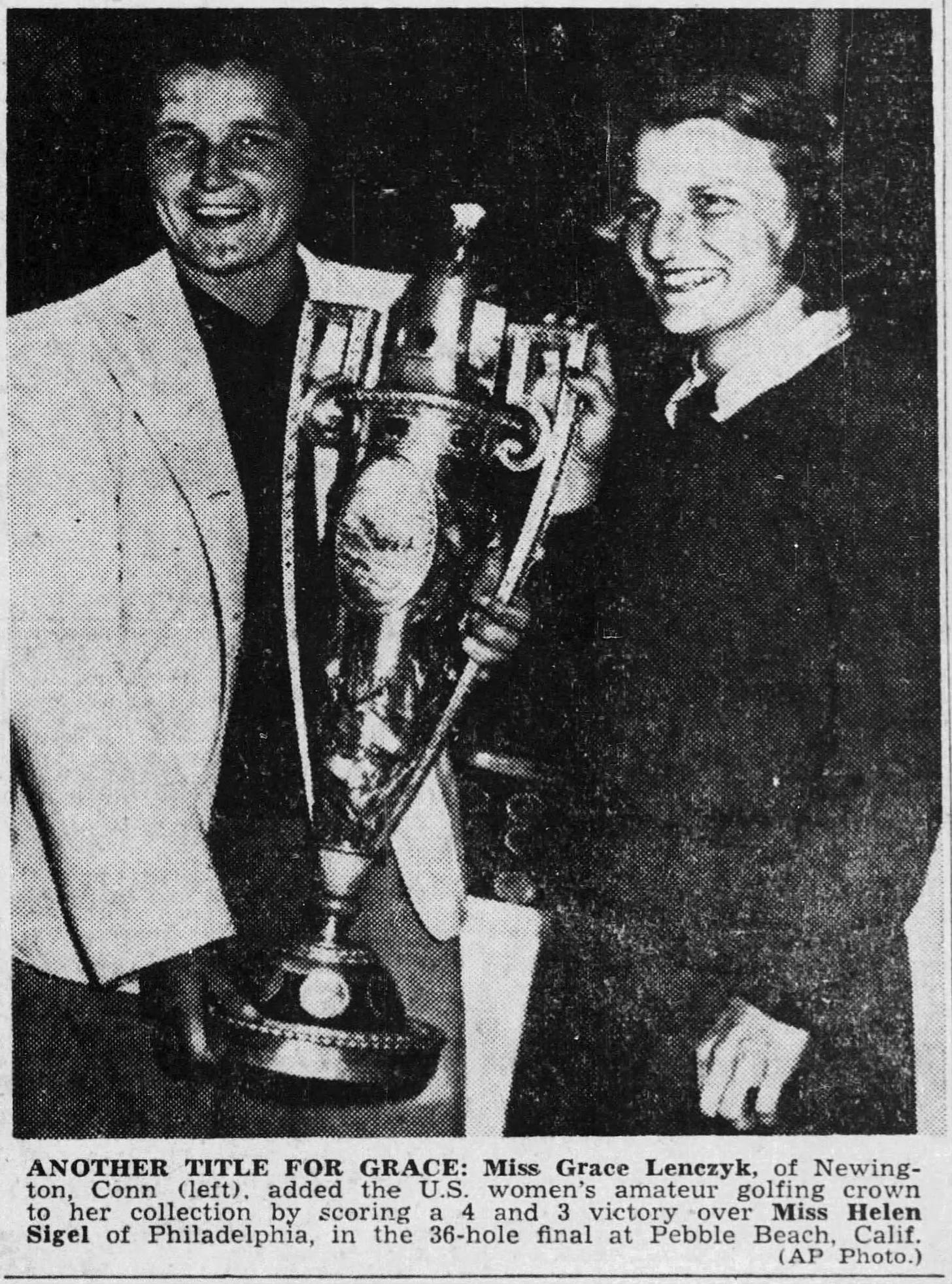
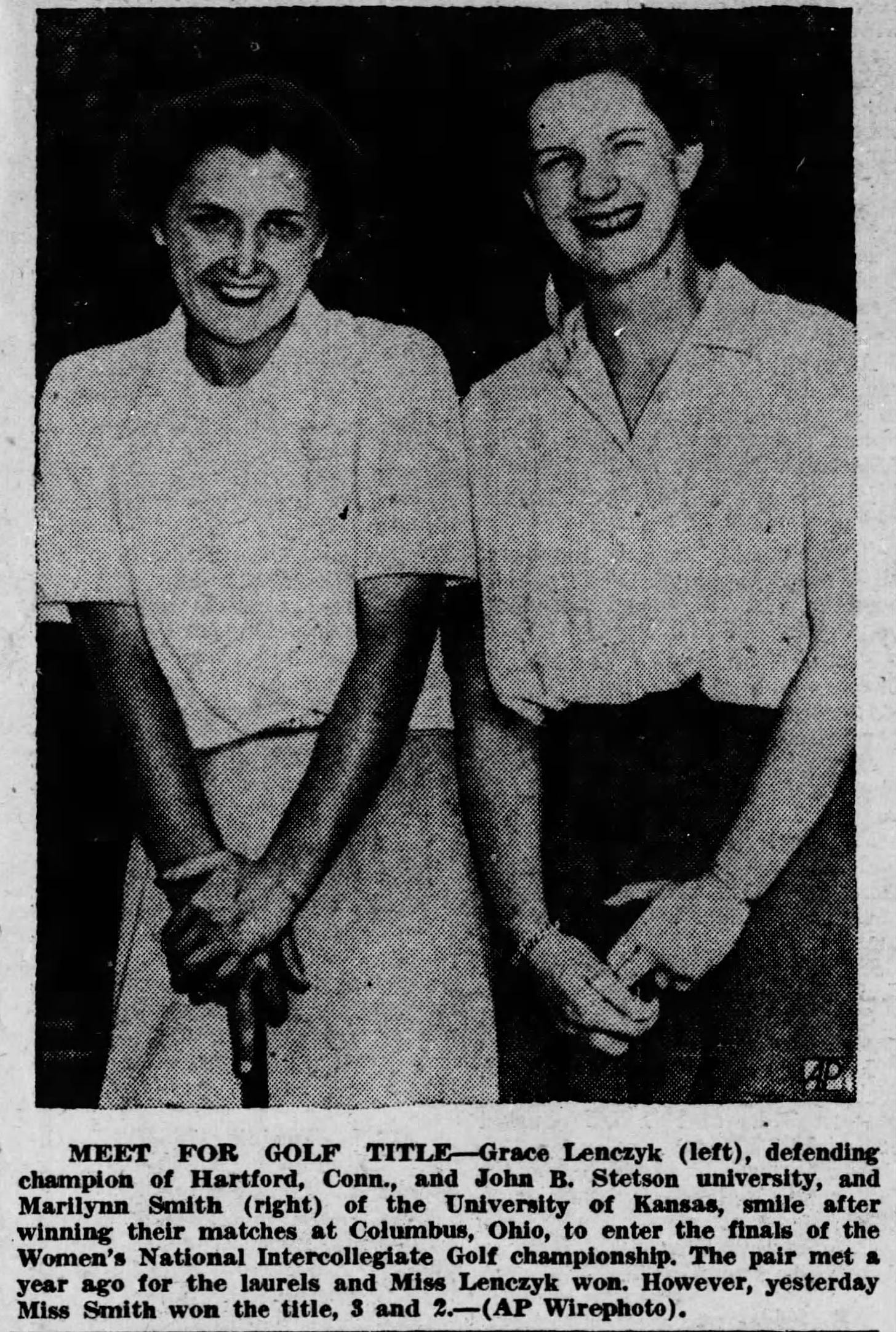
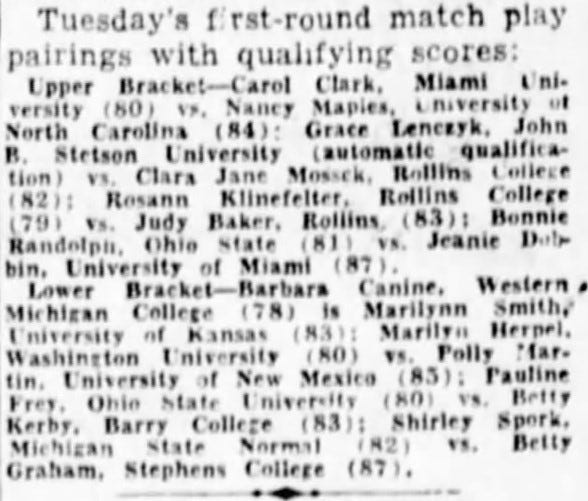

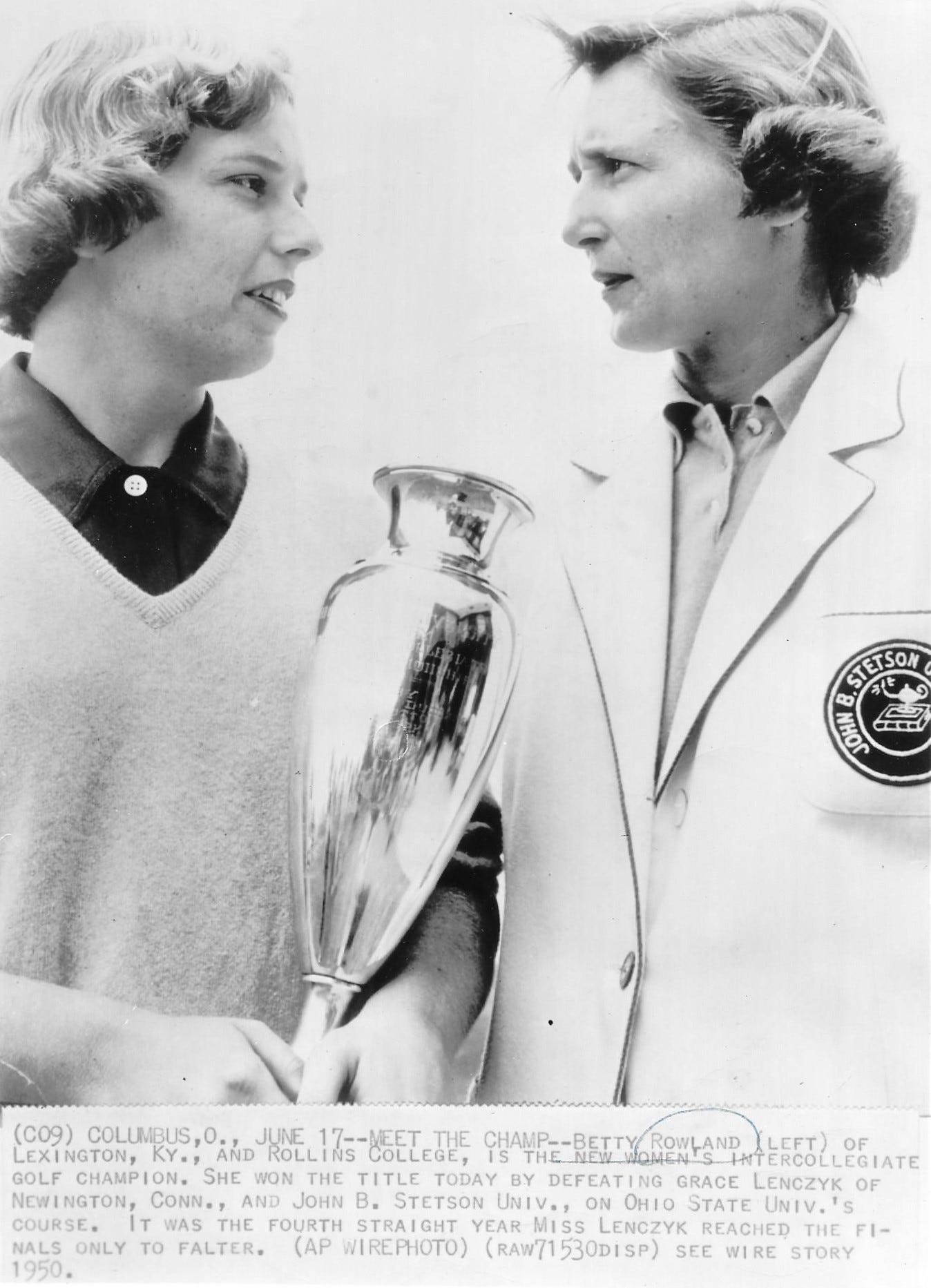
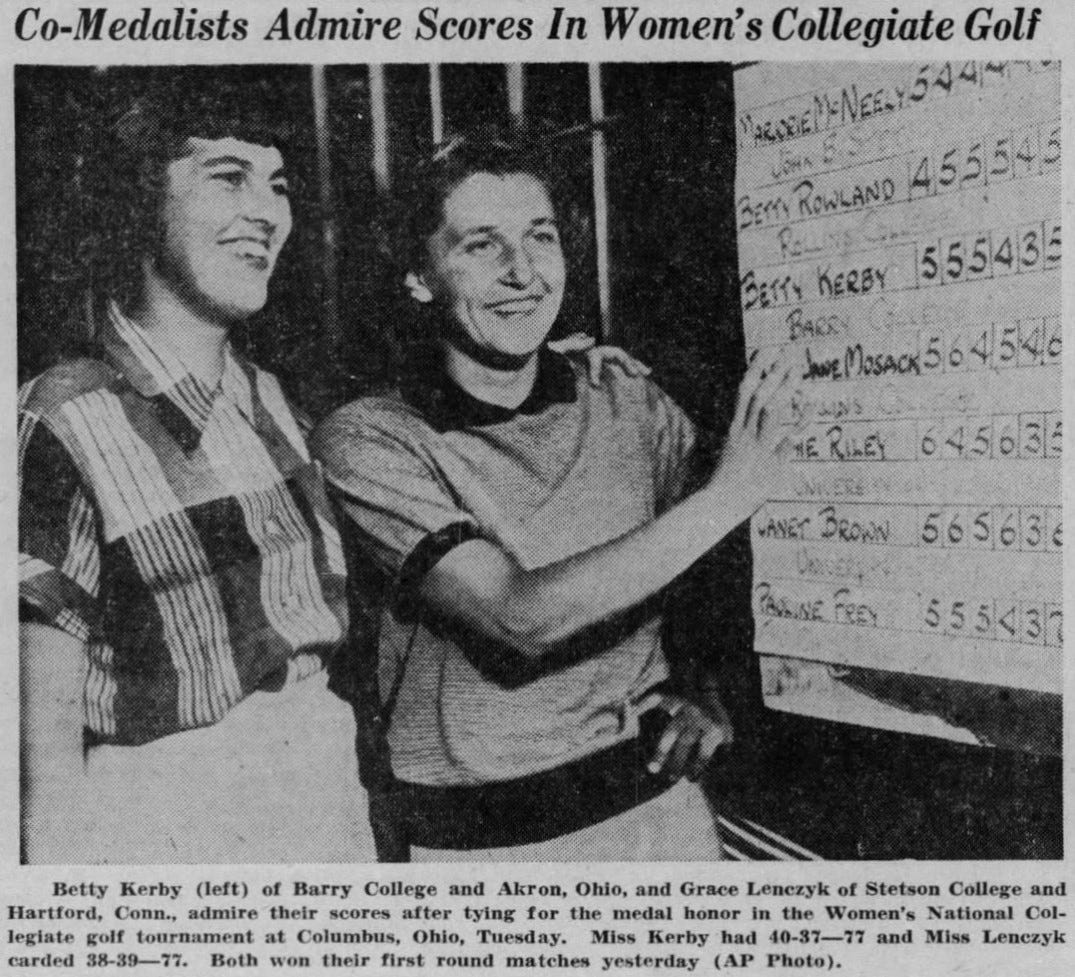
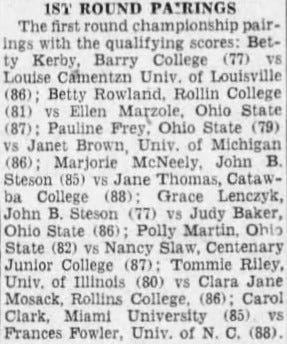
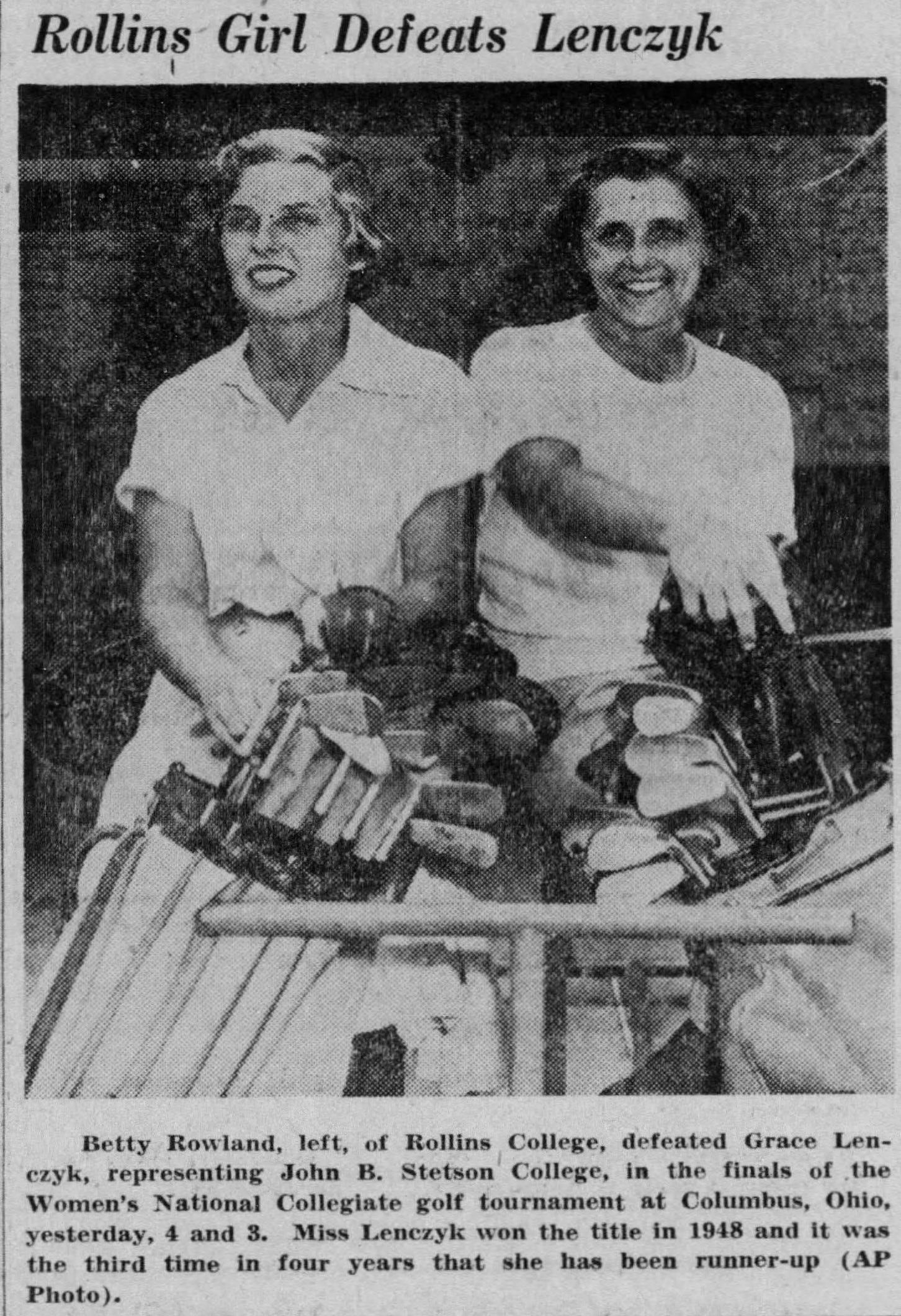
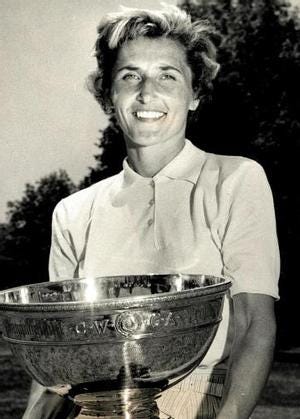
Incredible tribute to a truly incredible woman! It’s amazing to see the newspaper articles and her award jewelry box from that time!